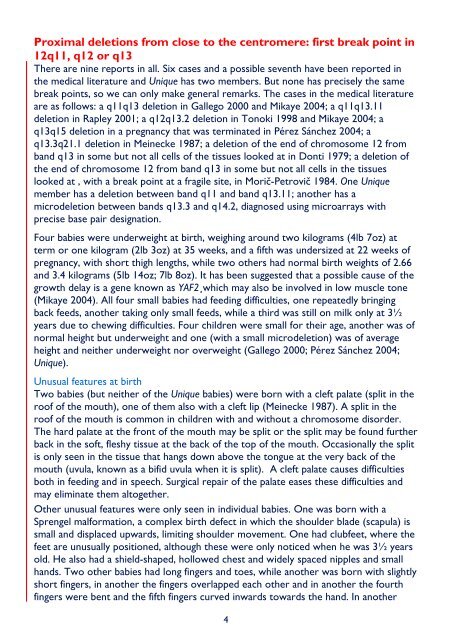12q deletion - Unique - The Rare Chromosome Disorder Support ...
12q deletion - Unique - The Rare Chromosome Disorder Support ...
12q deletion - Unique - The Rare Chromosome Disorder Support ...
You also want an ePaper? Increase the reach of your titles
YUMPU automatically turns print PDFs into web optimized ePapers that Google loves.
Proximal <strong>deletion</strong>s from close to the centromere: first break point in<br />
<strong>12q</strong>11, q12 or q13<br />
<strong>The</strong>re are nine reports in all. Six cases and a possible seventh have been reported in<br />
the medical literature and <strong>Unique</strong> has two members. But none has precisely the same<br />
break points, so we can only make general remarks. <strong>The</strong> cases in the medical literature<br />
are as follows: a q11q13 <strong>deletion</strong> in Gallego 2000 and Mikaye 2004; a q11q13.11<br />
<strong>deletion</strong> in Rapley 2001; a q<strong>12q</strong>13.2 <strong>deletion</strong> in Tonoki 1998 and Mikaye 2004; a<br />
q13q15 <strong>deletion</strong> in a pregnancy that was terminated in Pérez Sánchez 2004; a<br />
q13.3q21.1 <strong>deletion</strong> in Meinecke 1987; a <strong>deletion</strong> of the end of chromosome 12 from<br />
band q13 in some but not all cells of the tissues looked at in Donti 1979; a <strong>deletion</strong> of<br />
the end of chromosome 12 from band q13 in some but not all cells in the tissues<br />
looked at , with a break point at a fragile site, in Morič-Petrovič 1984. One <strong>Unique</strong><br />
member has a <strong>deletion</strong> between band q11 and band q13.11; another has a<br />
micro<strong>deletion</strong> between bands q13.3 and q14.2, diagnosed using microarrays with<br />
precise base pair designation.<br />
Four babies were underweight at birth, weighing around two kilograms (4lb 7oz) at<br />
term or one kilogram (2lb 3oz) at 35 weeks, and a fifth was undersized at 22 weeks of<br />
pregnancy, with short thigh lengths, while two others had normal birth weights of 2.66<br />
and 3.4 kilograms (5lb 14oz; 7lb 8oz). It has been suggested that a possible cause of the<br />
growth delay is a gene known as YAF2¸which may also be involved in low muscle tone<br />
(Mikaye 2004). All four small babies had feeding difficulties, one repeatedly bringing<br />
back feeds, another taking only small feeds, while a third was still on milk only at 3½<br />
years due to chewing difficulties. Four children were small for their age, another was of<br />
normal height but underweight and one (with a small micro<strong>deletion</strong>) was of average<br />
height and neither underweight nor overweight (Gallego 2000; Pérez Sánchez 2004;<br />
<strong>Unique</strong>).<br />
Unusual features at birth<br />
Two babies (but neither of the <strong>Unique</strong> babies) were born with a cleft palate (split in the<br />
roof of the mouth), one of them also with a cleft lip (Meinecke 1987). A split in the<br />
roof of the mouth is common in children with and without a chromosome disorder.<br />
<strong>The</strong> hard palate at the front of the mouth may be split or the split may be found further<br />
back in the soft, fleshy tissue at the back of the top of the mouth. Occasionally the split<br />
is only seen in the tissue that hangs down above the tongue at the very back of the<br />
mouth (uvula, known as a bifid uvula when it is split). A cleft palate causes difficulties<br />
both in feeding and in speech. Surgical repair of the palate eases these difficulties and<br />
may eliminate them altogether.<br />
Other unusual features were only seen in individual babies. One was born with a<br />
Sprengel malformation, a complex birth defect in which the shoulder blade (scapula) is<br />
small and displaced upwards, limiting shoulder movement. One had clubfeet, where the<br />
feet are unusually positioned, although these were only noticed when he was 3½ years<br />
old. He also had a shield-shaped, hollowed chest and widely spaced nipples and small<br />
hands. Two other babies had long fingers and toes, while another was born with slightly<br />
short fingers, in another the fingers overlapped each other and in another the fourth<br />
fingers were bent and the fifth fingers curved inwards towards the hand. In another<br />
4
















